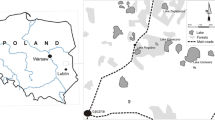Abstract
The dynamics of theCeratium hirundinella population and the abundance of dinocysts in the plankton and sediments were studied in Lake Sempach in 1988. In 1987, a rich population ofCeratium (380 cells ml−1) accompanied byPeridinium spp. developed in the lake. The dinocysts were found entrapped in a kind of flocs, in the deepest part of the lake, in the upper flocculent layer. The number of viable cysts ofCeratium in the sediments decreased gradually from April to July 1988. TheCeratium population increased slowly starting in April, and reached a maximum number in August (31 cells ml−1).Peridinium willei reached 100 cells ml−1. Newly formed cysts ofCeratium were recorded in the plankton and sediments at the end of July — beginning of August. They appear in the sediments as separate cells. Their number increased gradually, reaching a maximum of 600 cysts l−1 at the end of October.Ceratium formed more cysts than didPeridinium, but the rate of survival of theCeratium cysts appears to be lower than that ofPeridinium cysts. In addition to their biological functions, the cysts also have an impact on the ecosystem as carriers of nutrients from down to up and from up to down.
Similar content being viewed by others
References
Ambühl, H., 1985. Technik der Präparation und Darstellung von Sediment Kernen mit grossem Querschnitt. Schweiz. Z. Hydrol. 47:249–256.
Anderson, D. M. and D. Wall, 1978. Potential importance of benthic cysts ofGonyaulax tamarensis andGonyaulax excavata in initiating toxic dinoflagellate blooms. J. Phycol. 14:224–234.
Anderson, D. M., S. W. Chisholm and C. J. Watras, 1983. Importance of life cycle events in the population dynamics ofGonyaulax tamarensis. Mar. Biol. 76:179–189.
Anderson, D. M., D. M. Kulis and B. J. Binder, 1984. Sexuality and cyst formation in the dinoflagellateGonyaulax tamarensis: cyst yield in batch cultures. J. Phycol. 20:418–425.
Bloesch, J. and N. M. Burns, 1980. A critical review of sedimentation trap technique. Schweiz. Z. Hydrol. 42:15–55.
Bürgi, H. R. and P. Stadelmann, 1991. Plankton succession in Lake Sempach, Lake Hallwil and Lake Baldeggo before and during internal restoration measures. Verh. Int. Verein. Limnol. 24:931–936.
Chapman, D. V., J. D. Dodge and S. J. Heaney, 1982. Cyst formation in the freshwater dinoflagellateCeratium hirundinella (Dinophyceae). J. Phycol. 18:121–129.
Davis, M. B., 1968. Pollen grains in lake sediments: redeposition caused by seasonal water circulation. Science 162:93–94.
Heaney, S. J., D. V. Chapman and H. R. Morison, 1983. The role of the cyst stage in the seasonal growth of the dinoflagellateCeratium hirundinella within a small productive lake. Br. Phycol. J. 18:47–59.
Heaney, S. J., W. J. P. Smyly and J. F. Talling, 1986. Interactions of physical, chemical and biological processes in depth and time within a productive English lake during summer stratification. Int. Revue ges. Hydrobiol. 71:441–494.
Huber, G. and F. Nipkow, 1922. Experimentelle Untersuchungen über die Entwicklung vonCeratium hirundinella O.F.M. Z. Bot. 14:337–371.
Huber, G. and F. Nipkow, 1923. Experimentelle Untersuchungen über Entwicklung und Formbildung vonCeratium hirundinella O.F. Muller. Flora 116:114–215.
Livingstone, D., 1979. Algal remains in recent lake sediments. Ph. D. Thesis, University of Leicester [cited by Heaney et al., 1983].
Livingstone, D., 1984. The preservation of algal remains in recent lake sediments. In: Haworth, E. Y. and J. W. G. Lund (eds.), Lake Sediments and Environmental History. Leicester Univ. Press, pp. 191–202.
Pfiester, L. A., 1976. Sexual reproduction ofPeridinium willei (Dinophyceae). J. Phycol. 11:259–265.
Pfiester, L. A., 1977. Sexual reproduction ofPeridinium gatunense (Dinophyceae). J. Phycol. 13:92–95.
Pollingher, U., 1987. Ecology of dinoflagellates. In: Taylor, F. J. R. (ed.), The Biology of Dinoflagellates. B. Freshwater Ecosystems. Botanical Monographs 21. Oxford: Blackwell, pp. 502–529.
Pollingher, U., 1988. Freshwater armored dinoflagellates: growth, reproduction strategies and population dynamics. In: Sandgren, C. (ed.), Growth and Reproduction Strategies of Freshwater Phytoplankton. Cambridge: Cambridge Press, pp. 134–174.
Pollingher, U., 1990. Effect of latitude on phytoplankton composition and abundance in large lakes. In: Tilzer, M. and C. Serruya (eds.), Ecological Structure and Function in Large Lakes. Springer Verlag, pp. 368–402.
Pollingher, U. and B. Hickel, 1991. Dinoflagellate associations in a subtropical lake (Lake Kinneret, Israel). Arch. Hydrobiol. 120:267–285.
Pollingher, U. and C. Serruya, 1976. Phased division ofPeridinium cinctum fawestii and the development of the bloom in Lake Kinneret (Israel). J. Phycol. 12:162–170.
Pollingher, U. and E. Zemel, 1981.In situ and experimental evidence of the influence of turbulence on cell division processes ofPeridinium cinctum fa.westii (Lemm.) Lefevre. Br. Phycol. J. 16:281–287.
Reynolds, C. S., 1984. The Ecology of Freshwater Phytoplankton. Cambridge: Cambridge University Press.
Robinson, N., G. Eglinton, S. C. Brassell and P. A. Cranwell, 1984. Dinoflagellate origin for sedimentary 4α-methylsteroids and 5α(H)stanols. Nature 308:439–441.
Robinson, N., P. A. Cranwell, G. Eglinton, S. C. Brassell, C. L. Sharp, M. Gophen and U. Pollingher, 1986. Lipid geochemistry of Lake Kinneret. Org. Geochem. 10:733–742.
Stabel, H. H., 1986. Calcite precipitation in Lake Constance: chemical equilibrium, sedimentation and nucleation by algae. Limnol. Oceanogr. 31:1081–1093.
Stadelmann, P., 1988. Der Zustand des Sempachersees. Wasser, Energie, Luft 3/4:81–96.
Steenbergen, C. L. M., 1982. Phytoplankton periodicity and sediment trap recoveries. Prog. Rep., Limnol. Inst., Nieuwersluis, pp. 33–35.
Stumm, W., 1987. Aquatic Surface Chemistry. Wiley-Interscience.
Utermöhl, H., 1958. Zur Vervollkommnung der quantitativen Phytoplanktonmethodik. Mitt. Int. Ver. Limnol. 9:1–38.
Wall, D., 1971. Biological problems concerning fossilizable dinoflagellates. Geosci. Man. 3:1–15.
Weilenman, U., C. R. O'Melia and W. Stumm, 1989. Particle transport in lakes: models and measurements. Limnol. Oceanogr. 34:1–18.
Author information
Authors and Affiliations
Rights and permissions
About this article
Cite this article
Pollingher, U., Bürgi, H.R. & Ambühl, H. The cysts ofCeratium hirundinella: Their dynamics and role within a eutrophic (Lake Sempach, Switzerland). Aquatic Science 55, 10–18 (1993). https://doi.org/10.1007/BF00877255
Received:
Accepted:
Issue Date:
DOI: https://doi.org/10.1007/BF00877255




